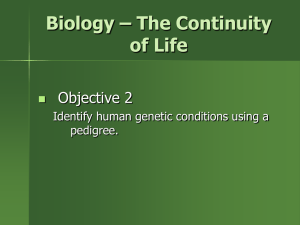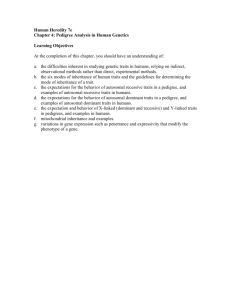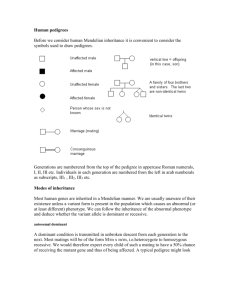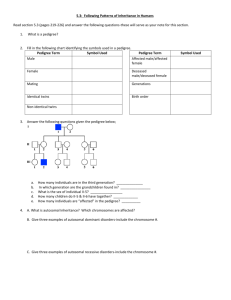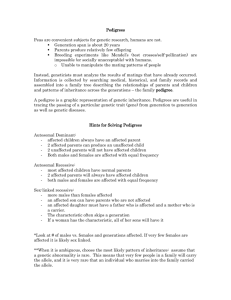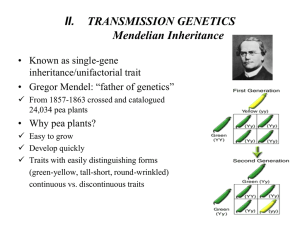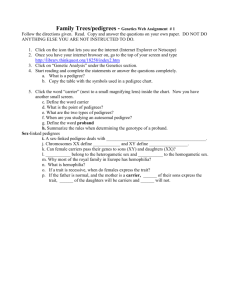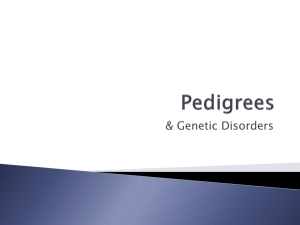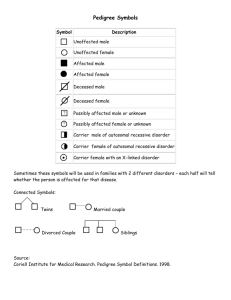Pedigrees
advertisement
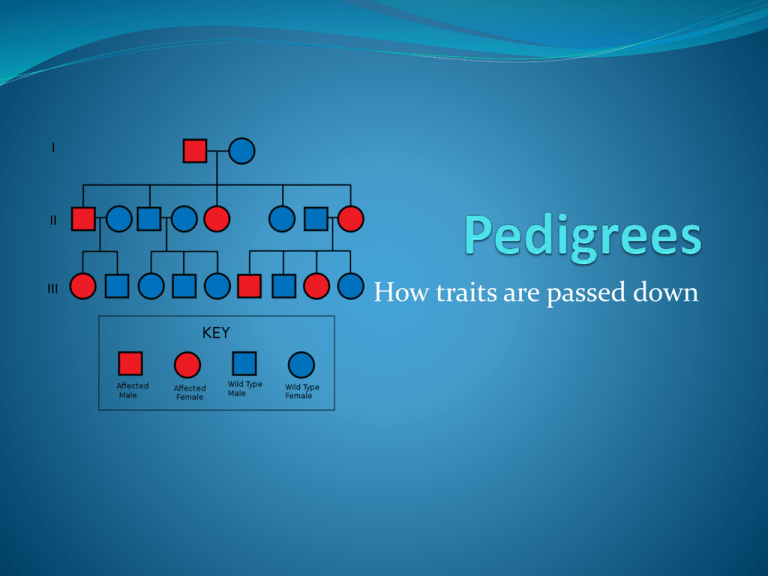
How traits are passed down Warm Up 3/20/12 Read the scenario below and create a punnet square based on the information given. Andy and Amy just got married. Andy has brown hair with a genotype of Bb. Amy is a blond with the genotype of bb. 1. Tell me where the female and male alleles would be placed on the punnet square. 2. Create a punnet square that would show the possible outcomes of their offspring. 3. What percentage of their children would have blond hair? How do you know? Announcements Extra credit projects are due on Monday of next week (3/26). I will not be able to stay after on Thursday and Friday of this week! If you need make up work see me in the morning! Think and write: 10 Read the questions below and pick one to answer. Be sure to stop and think before you answer it. Be sure to use proper grammar and punctuation. Do you resemble (look like) anyone in your family? How do you know. 2. Are their in diseases in your family that are common? How do you know? How has that influenced your behavior? 1. Pedigrees -Scientists use pedigrees to track genes over generations. -Pedigrees are family trees which show which individuals in the family get certain diseases. VII. Pedigree Male Parents Female Siblings Affected male Affected female Mating Known heterozygotes for recessive allele Death Pedigrees illustrate inheritance How to read a pedigree Horizontal lines connecting a male and female represent mating. Vertical lines pointing down from a couple represent their children. Subsequent generations (or the next generation) are written underneath the parents and the oldest individuals are found at the top of the pedigree. Why do we need pedigrees? If the purpose of a pedigree is to analyze the pattern of inheritance of a particular trait, it is common to shade in the symbol of all individuals that possess this trait. In the pedigree below, the grandparents had two children, a son and a daughter. The son had the trait in question. One of his four children also had the trait. For example: VII. Pedigrees Pedigrees illustrate inheritance A half-shaded circle or square represents a carrier, a heterozygous individual. VII. Pedigrees Pedigrees illustrate inheritance I 1 2 II 2 1 III ? IV 1 2 1 3 4 4 3 2 5 3 4 5 A horizontal line connecting a circle and a square indicates that the individuals are parents, and a vertical line connects parents with their offspring. VII. Pedigrees Pedigrees illustrate inheritance I 1 2 II 2 1 III ? IV 1 2 1 3 4 4 3 2 5 3 4 5 A horizontal line connecting a circle and a square indicates that the individuals are parents, and a vertical line connects parents with their offspring. Generations Each row on a pedigree indicates a different generation. For example, children of parents represent a generation. Lets call them F1 When those children have children they create a new generation. We would call them F2. Guided Practice We are going to practice analyzing pedigrees using the skills we JUST learned. If you forget something, its ok. Look back at your notes to answer the questions. You will be given a pedigree practice sheet Do Not write on it. Class set. Answer the questions quietly in your notebook. 15 minutes. Review Take two minutes to discuss your answers with a partner. Discuss: 1. Which questions did you find most difficult? 2. Why were they hard? 3. What information could I have given you to make it easier? Independent Practice You will complete questions 12-22 on your own. This will serve as your exit ticket. Warm Up 3/21/12 Fill in the blanks below: 1. Scientists use______________ to track genes over generations. 2. Pedigrees are ________________which show which individuals in the family get_________________. 3. What type of information do you get from a pedigree. Announcements Extra credit projects are due on Monday of next week (3/26). I will not be able to stay after on Thursday and Friday of this week! If you need make up work see me in the morning! Patterns of Inheritance Autosomal dominant Autosomal recessive X-linked recessive What does this mean? Autosomal Dominant If a disease is autosomal dominant, it means you only need to get the abnormal gene from one parent in order for you to inherit the disease. In many cases, one of the parents have the disease. Dominant inheritance means an abnormal gene from one parent is capable of causing disease, even though the matching gene from the other parent is normal. The abnormal gene "dominates" the pair of genes. If just one parent has a dominant gene defect, each child has a 50% chance of inheriting the disorder. Example: Huntington’s Disease For example For example, if four children are born to a couple and one parent has an abnormal gene for a dominant disease, statistically two children will inherit the abnormal gene and two children will not. Children who do not inherit the abnormal gene will not develop or pass on the disease. Autosomal recessive An autosomal recessive disorder means two copies of an abnormal gene must be present in order for the disease or trait to develop. If you are born to parents who both carry an autosomal recessive change (mutation), you have a 1 in 4 chance of getting the malfunctioning genes from both parents and developing the disease. You have a 50% (1 in 2) chance of inheriting one abnormal gene. This would make you a carrier. Example: Sickle Cell Anemia Example of recessive: Ms. Adeeyo’s dad is African and carries the gene for sickle cell. Ms. Adeeyo’s mom is from the USA and does not. Thus, I have a ¼ chance of inheriting the gene from 1 parent. As a result, my parents had a 25% chance of having a child with sickle cell. My parents had a 50% chance of having children that are carriers of the mutation. Both my sister and I are carriers of the mutation. So, if my parents had more kids, they would be more likely to either have the disease or not carry the gene at all. X-linked recessive Inheritance of a specific disease, condition, or trait depends on the type of chromosome affected (autosomal or sex chromosome). It also depends on whether the trait is dominant or recessive. Sex-linked diseases are inherited through one of the sex chromosomes (the X or Y chromosome). Example:Hemophilia and Muscular Dystrophy Quick check for understanding Which of the following is an example of an autosomal dominant disease? A) Huntingtons? B) Sickle Cell C) Hemophilia 1. Quick check part 2 2. Explain in your own words why Sickle Cell would be considered a recessive disease? Pedigree Simulation: Directions You are going to use this as a way to “experience” how diseases like Sickle Cell, Hemophilia and Huntington’s are passed down. You will receive a worksheet to record your genotypes on. You (Students) will partner up and pick allele cards to determine their genotypes and if you have a disease. Then, you will randomly contribute one card each to simulate offspring production and record the genotypes of their offspring with the allele cards. This will be done three times. Lastly, you will choose one disease and form a pedigree from this information using correct symbols for gender, and who's affected. Exit ticket If you are born to parents who both carry an autosomal recessive change (mutation), you have a _________ chance of getting the malfunctioning genes from both parents and developing the disease. 2. Hemophilia is an example of an _______________ disease. 3. If a disease is autosomal dominant, it means you only need to get the abnormal gene from ________________in order for you to inherit the disease. 1. Warm Up 3/21/12 What does a pedigree chart show? 2. Based on your knowledge from punnet squares, write a paragraph discussing the role of probability in the passing of genetic traits to offspring. 1. Announcements Test on Friday! Mini-Project Today’s mini-project will be creating your own Family Pedigree Chart. You will use the rubric seen below. You will also be earning class participation points for this activity. Outline and Roughdrafts Take 30 minutes to jot down your thought process. This should guide your thinking on how to make your final draft. Final draft Warm Up 3/22/12 What did you learn from your family pedigree? Are their traits being passed on that you were unaware of? Announcemnts Study guide for the test is posted on my website. Extra credit due soon. Get ready for the test tomorrow Stations: when pedigrees go wrong Different stations around the room have various articles about pedigrees and diseases. Stations Disease Station 1 Station 2 Station 3 Station 4 Station 5 Which pattern of How it affects a heredity is this? person? What happens to your body’s ability to maintain homeostasis? Argue your point After reading the article about puppy mills, the russian royal family and other types of inbreeding how do you feel? Do you think that it is right to selectively breed dogs in this way? Respond to this question by making a claim, supporting it with evidence and using supporting details from the argument? The first draft will serve as a rough draft while the final draft will be your exit slip! Warm Up 3/13/12 If you are born to parents who both carry an autosomal recessive change (mutation), you have a _________ chance of getting the malfunctioning genes from both parents and developing the disease. 2. Hemophilia is an example of an _______________ disease. 3. If a disease is autosomal dominant, it means you only need to get the abnormal gene from ________________in order for you to inherit the disease. 1. Announcements Test today! Please place all make up work in the bin! 10 minute review Time to ask me any questions before we begin. Testing! Please begin your test. Good luck
